#the angel of chimerical transformation
Text
Name: William “Will” Baker
Alias: S. Killer
Race: Metahuman/Unique Physiology hybrid
Gender: Male
Age: 17
Birth Day: June 6, 2005
Species: Homo sapiens/Metahuman hybrid
Alignment: Chaotic Neutral (The Rebel)
Sexuality: Heterosexual
Hair color: Black (dyed: Red)
Hairstyle: Short and messy
Eye color: Blue (right eye), Gray (left eye) - Heterochromia
Height: 6 feet
Weight: 160 lbs
Personal Data:
• Birthplace: New York City, New York, United States
• Affiliation: Independent
• Occupation: Freelance Hacker, Underground Street Performer, Urban Explorer, Informal Detective, Social Media Influencer, Part-Time Instructor, Occasional Performer, Artist, martial arts, Journalist, musician, singer, Actor, Athlete, Blacksmith, Chess player, anti-hero, Marksman, Screenwriter, Street artist, Weaponsmith, Race driver, Animator, Author, Baker, Boxer, Chef, Cook, Costume designer, Dancer, Designer, Dog walker, Driver, Football player, Fortune teller, Goldsmith, Guitarist, Gunsmith, Illusionist, Karate master, Kickboxer, Locksmith, Printer, Rockstar, Sportsman, Street artist, Street musician, dog walker, Voice actor, Wrestler, Writer, YouTuber
• Base of Operation: Dead Mall (Safe House/Hideout) and Mobile HQ
Relationship:
• Partner: Joan “Jo” Johnson/Jojo/The Stalker
• Pets:
Family:
• Father: David Baker (Former Special Forces operative turned tech entrepreneur)
• Mother: Sarah Baker (Archaeologist and historian)
• Uncle: Jonathan Baker (Former intelligence officer turned private investigator)
• Aunt: Rebecca Baker (Environmental scientist)
• Cousin: Lily Baker (Age: 16, Energetic, outgoing, with a rebellious streak)
• Siblings:
• Twin: Gwendolyn “Gwen” Baker
• Brother: Nicholas “Nick” Baker
• Sister: Elizabeth “Liz” Baker
• Step-Siblings:
• Twins: Alex and Emily (Age: 15, Initially distant due to blended family dynamics, but they eventually bond over shared interests and experiences)
Pets: Rebel, the Canine Companion (Chimerism canine), Echo, the Siberian Husky (Giant Animal/Ice Animal/Canine hybrid), Lucifer, the Doberman (Demonic Beast/Giant Animal/Canine hybrid), Queen, the German Shepherd (Earth Animal/Alien Animal/Canine hybrid), King, the Labrador (Cartoon Canine), Blaze, the Majestic Golden Retriever (Fire Animal/Giant Animal/Canine hybrid), Barkley, the Golden Retriever (Electrical Animal/Canine hybrid), Rex, the German Shepherd (Chimerism/Dinosaur Canine hybrid), and Shadow, the Mixed Breed (Black Dog/Warg/Canine hybrid).
Nationality: British American (Ancestry in Anglo-Saxon and Vikings)
Appearance:
In his base/human form, William “Will” Baker possesses a striking presence, standing tall with a lean, athletic build that speaks to his agility and strength. His facial features include an inverted triangle face and a mesomorphic inverted triangle body, emphasizing his rugged charm and athleticism. His hooded eyes, one blue and the other gray due to heterochromia, add an intriguing allure to his gaze, hinting at his mysterious nature. Vibrant red hair, intentionally dyed, serves as a bold contrast against his dark attire, enhancing his rebellious persona. Will’s intentionally messy hairstyle, with tousled locks framing his face, reflects his carefree and adventurous spirit.
In his Toon/Ultimate form, William “Will” Baker undergoes a dramatic transformation, manifesting enhanced physical attributes and a surreal appearance that reflects his heightened abilities. His mesomorphic inverted triangle body becomes more pronounced, exuding power and strength. His facial features retain their inverted triangle shape, with glowing vertical pupils—a mix of blue and gray—emitting an otherworldly radiance. His hair transforms into a fiery display of blue and gray hues, resembling flames dancing atop his head. A skull-like lower jaw emerges, adding a menacing aspect to his appearance, along with demonic horns and a broken halo hovering above. His wings take on a dual nature, with the right side angelic and the left side demonic, symbolizing his internal conflict. His hands and feet morph into claws-like appendages, enhancing his combat prowess, while his elongated ears evoke an elf-like appearance. Fang retraction adds to his predatory aura.
Personality:
• Rebelliousness
• Adventurous
• Independent
• Curiosity
• Resourcefulness
• Complexity
• Protective
• Charismatic
• Playful and Whimsical
• Serious and Stoic
• Humorous and Mature
• Mysterious and Enigmatic
Power:
• Metahuman Physiology, Unique Physiology, Cartoon Physiology, Hybrid Physiology, Energy/Personal Energy Manipulation, Aura Manipulation, Logic Manipulation, Fiction Manipulation, Universal Manipulation, Multiversal Manipulation, Crossover Manipulation, Property Manipulation, Illusion Manipulation, Telepathy, Telekinesis, Elemental Manipulation, Periodic Element Manipulation, Teleportation, Force-Field Generation, Physics Manipulation, Flight/Levitation/Gliding, Shapeshifting, Regenerative Healing Factor, Toon Force, Dimensional Manipulation, Absolute Replication, Elasticity, Imagination Manifestation, Size Manipulation, Body Manipulation, Biological Manipulation, 4th Wall Manipulation, Meta Manipulation, Plot Manipulation, Character Imitation, Biomorphing, Invisibility, Super Eating, Enhanced Condition, Enhanced Proprioception, Enhanced Motor Skills, Body Part Manipulation, Conditional Transformation/Transformation, Partial Transformation, Mode Switching, Personal Wardrobe/Clothing Generation, and Musical Inducement.
Abilities:
• Jack of All Trades, Mechanical Mastery, Science Mastery, Martial arts Mastery, Psychological Mastery, Archetype:Master Chef, Writer Mastery, Multilingualism, Musicianship Mastery (and/or Musical Mastery), Artistic Mastery, Archetype:Detective, Investigation Mastery, Preternatural Studies Mastery, Performance Art Mastery, Humor Mastery, Prank Mastery, Chess Mastery, Game Mastery, Archetype:Fortune Teller, Weapon Proficiency, Canine Companionship, Weapon Proficiency Touch, Enhanced Parkour (Parkour Mastery), Enhanced Inventing (Genius Inventing), Craftsmanship Mastery, Engineering Mastery, Sport Mastery, Improbable Weapon Proficiency, Combat Merging, Enhanced Memory, Enhanced Accuracy, Enhanced Gunmanship, Enhanced Archery, Enhanced Spearmanship, Enhanced Swordsmanship, Enhanced Flailmanship, Enhanced Clawmanship, Ability Learning, Riddle Mastery, Hacking Mastery, Boarding Mastery, Hybrid Weapon Proficiency, Hypercompetence, Archetype:All-Rounder, Archetype:Anti-Hero, Archetype:Child Prodigy, and Archetype:Comic Relief
Fighting Style
• Fighting Style: Bartitsu, Brazilian Jiu-Jitsu, Boxing, Kickboxing, Budō/Bujutsu, Aikido, Bajutsu, Bisentōjutsu, Bōjutsu, Bōryaku, Hojutsu, Hojutsu, Iaido, Jujutsu, Judo, Kanabō, Karate, Gōjū-ryū, Kayakujutsu, Kempo, Kendo, Kenjutsu, Kyudo, Kyūjutsu, Kyushojitsu, Naginatajutsu, Sōjutsu, CQC, Defendu, Marine Corps Martial Arts Program, Capoeira, Eskrima, Stick-Fighting, Kobudō, Krav Maga, Kung Fu, Drunken Fu, Five Animals, Bajiquan, Sanshou, Shaolin Kung Fu, Tai Chi, Wing Chun, Fa Jin, Jeet Kune Do, Muay Thai, Savate, Silat, Systema, Tricking, Tae Kwon Do, Wrestling, Lucha libre-style Wrestling, Sambo, Pankration, Vale Tudo, Ninjutsu, Intonjutsu, Shurikenjutsu, Elemental Martial Arts, Fictional Martial Arts, Gun Kata, Hollywood Martial Arts, Superhuman Martial Arts, and Street fighting.
Weapons:
• Gauntlet and Brass Knuckle (mixed)
• Katana
• Rapier
• Shotgun
• Handgun
• Sniper Rifle
• Assault Rifle
• Dual Handgun
• Machine Gun
• Dual Spear
• Javelin
• Lance
• Multi-Section Spear
• Bayonet
• Short Spear
• Trident
• Yari
• Scythe
• Kama
• Sickle
• Grapnel with hook
• Meteor Hammer
• Kyūdō
• Longbow
• Crossbow
• Chain Axe
• Double-Sided Axe
• oversize Mallet from In his Toon/Ultimate form
• Shield
• Baseball Bat
• Toon Arsenal from In his Toon/Ultimate form
Special Techniques:
• Shadow Dance
• Chaos Fist
• Elemental Harmony
• Toon Transformation
Paraphernalia:
• Utility Belt
• Augmented Reality Glasses
• Throwing Knives
• Smoke Bombs
Musical Instrument:
• Electric Guitar
• Violin
• Ukulele
Dance Style:
• Urban Street Dance
• Contemporary Dance
• Hip-hop
• Breakdancing
• Modern Dance
Bio
William “Will” Baker was born in New York City to a family with a diverse background. His upbringing exposed him to various cultures, disciplines, and experiences, shaping him into the multifaceted individual he is today.
From a young age, Will displayed an insatiable curiosity and a rebellious spirit, always seeking adventure and excitement. His natural talents and boundless energy led him to excel in a wide range of activities, from hacking and urban exploring to martial arts and music.
As he grew older, Will’s thirst for knowledge and adventure only intensified, leading him to embark on a journey of self-discovery and exploration. Along the way, he encountered a diverse cast of characters, forming deep bonds and alliances that would shape his destiny.
Now, as a young adult, Will continues to push the boundaries of what is possible, using his unique talents and abilities to navigate the complexities of the world around him. With his loyal companions by his side, he faces each new challenge with courage, determination, and an unwavering commitment to his own sense of justice and adventure.
William “Will” Baker/S. Killer (c) Me
0 notes
Text
LA / Sarah Elizabeth Cornejo: That Which We Fear, That Which We Love

Sarah Elizabeth Cornejo: That Which We Fear, That Which We Love
December 2 - 17, 2023
Opening Reception: Saturday, December 2nd 7-10pm
“To speak to the core that creates and swallows, to speak not always to what’s shouting, but to what’s underneath asking for nothing. I am at the mouth of the cave. I am willing to crawl.” - Ada Limón
Tiger Strikes Asteroid Los Angeles is thrilled to present That Which We Fear, That Which We Love, the first solo presentation of Sarah Elizabeth Cornejo’s work in Los Angeles. Selected from a group of more than four hundred applicants who applied for the 2023 Los Angeles Open Call, Sarah Elizabeth Cornejo’s work is a testament to the strength and vitality of contemporary artists working today, not only in major art centers like Los Angeles and New York, but in other parts of the US like Memphis, Tennessee where Cornejo is currently based.
Cornejo’s work confronts us with a world both alien and familiar, scientific in appearance yet mythological in character. In the artist’s words “That Which We Fear, That Which We Love presents observations of human time from the perspective of serpentine figures from Latin American myth, dwelling within a liminal space at the center of the Earth.” Utilizing a range of traditional and non-traditional media to create drawings, sculptures, textiles, and installations, Cornejo explores the possibilities within hybridity as a way to respond to the “troubled present in the wake of humanity’s destructive path.” Cornejo’s work weaves a beautiful alternative vision of hybrid life; a vision that challenges the current inclination toward an Anthropocene view of the world, perhaps indicating a shift to what the artist calls a “chimeric future” enhanced by technology.
For the exhibition the artist has created a series of site specific mixed-media sculptural works and drawings laser-cut into mirror. The work draws on a rich range of found and repurposed materials that includes organic and geological artifacts that speak to the hybridity and alchemical transformation at the core of Cornejo’s work.
Sarah Elizabeth Cornejo is a Peruvian-American interdisciplinary artist based in Memphis, TN. Her work has been shown at The Mint Museum (NC), Duke University (NC), Crosstown Arts (TN), Field Projects (NY), and Antenna (LA), among others, and was most recently included in the statewide Tennessee Triennial. She has been awarded residencies at Crosstown Arts and the McColl Center, and received the Current Art Fund Grant (2021), Tennessee State Fellowship (2022), and was the finalist for the 2022 Southern Prize. She received her MFA in interdisciplinary studio from The University of North Carolina at Chapel Hill and her BA in Studio Art and English Literature from Davidson College.



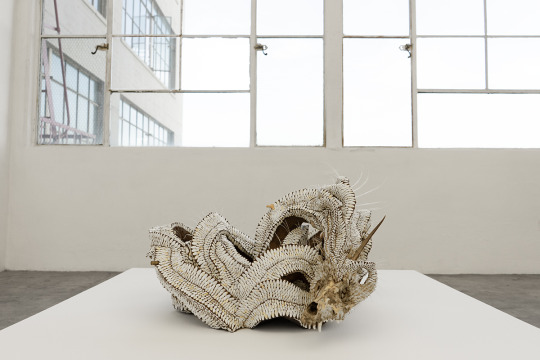
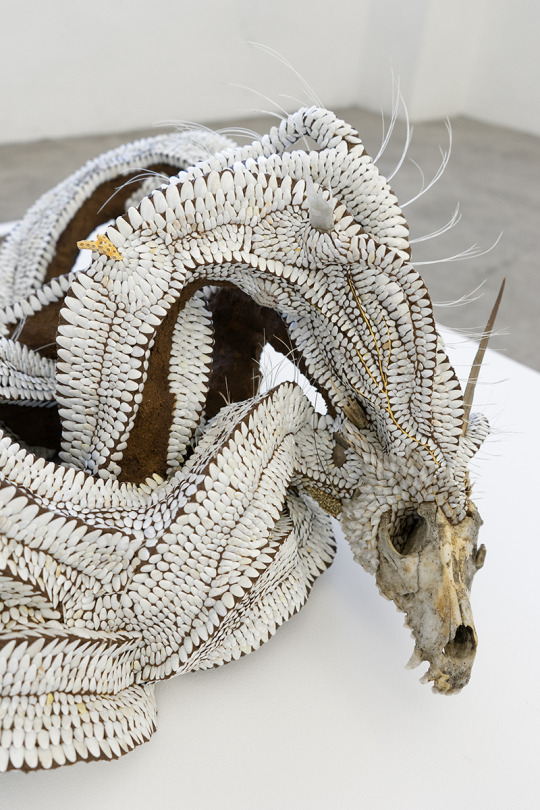


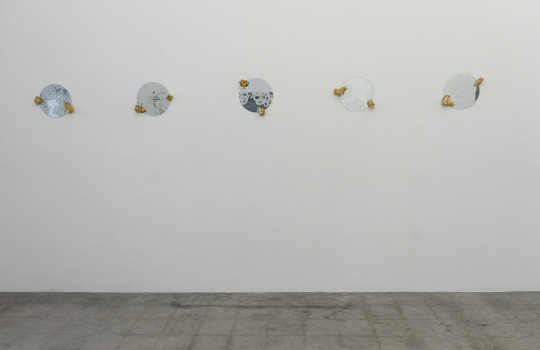



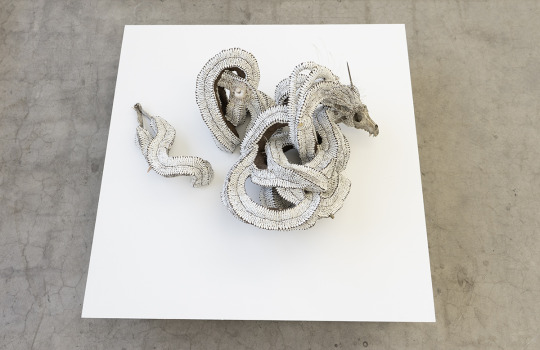


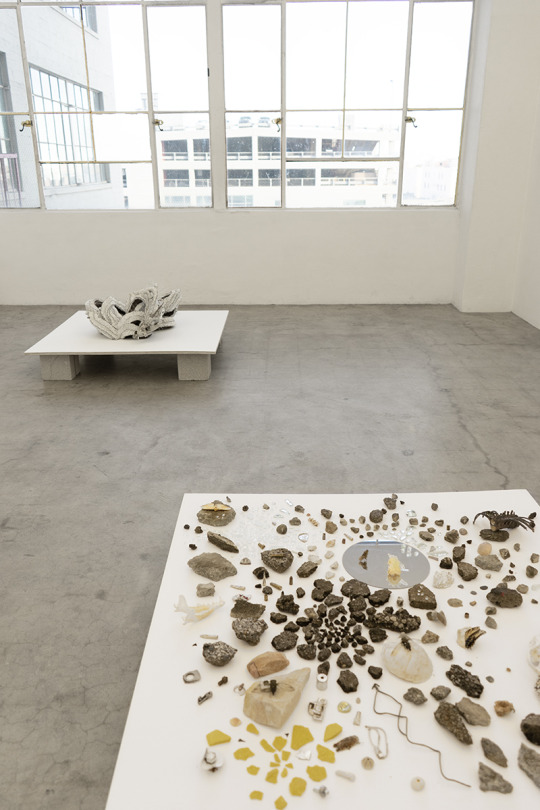





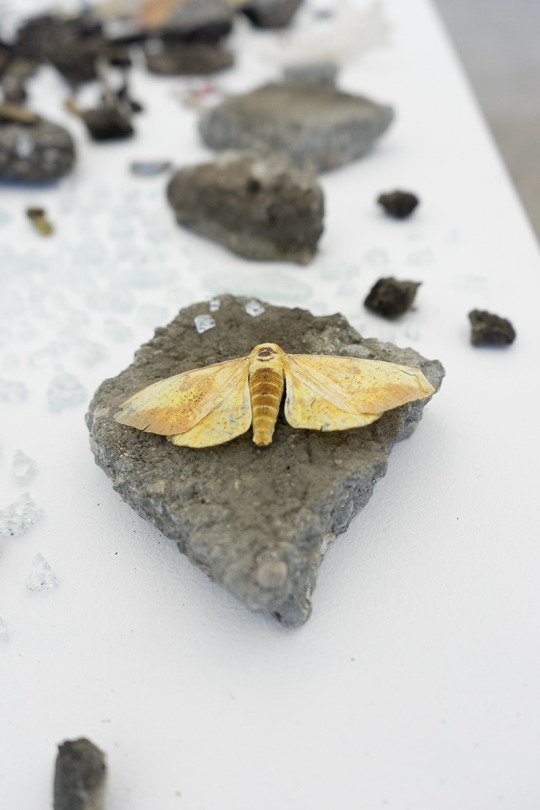
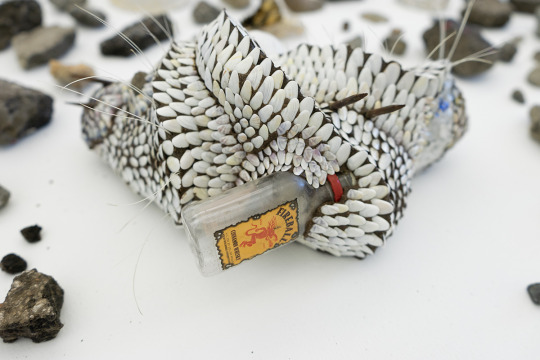





photos by Gemma Lopez
0 notes
Text
Morphlings, Anamilia, abominations and other shapeshifters.
These creatures all share the ability to shape-shift into a another animalistic creature.
The main difference between anamilia shifters and morphlings is the number of creatures they can transform into. Morphlings are only able to shape change into one other creature. While anamilia shifters can shape shift into any number of creature. Though they tend to have some kind of personal limit. The lowest limit is often one or two while the highest recorded number is 72.
Other shape shifters that are relatives of the anamilia like horria shifters and monstira shifters often have similar numerous transformations. Monstira shifters can often turn into any verity of chimeric combinations and physical alterations of thier number of different animals, usually the number of different species they can shape shift into are combined in thier chimera forms. Horra shifters are generally much more limited in what part of thier body they can alter but often have a great number of different ways they can alter that body part.
Abominations are the results of old, highly unethical experiments that where done mainly on humans from the iles of man by the Fay centuries ago before the decline of thier worldwide empire. Abominations don’t neatly fit into one kin or the other, some abominations fit better then others. Abominations come in several different kinds. The ones known to be the most prolific shapeshifters are the vessels. Sometimes called vesen due to that being the Fay word for animal. They have the ability to shape-shift part of their body into animal forms but not their entire body. They like their other two counterparts flowers and murals are considered failures by their original creators. Because these creatures don’t fit neatly as one kin or the other they are called abominations.
A lot of shapeshifters are thought to be related to vampires or be decedents of damphir
There are other kinds of shapeshifters. Some shape shifting is magic and some is not. Creatures like changelings and other Fay use magic to shapshift but for most it is a more natural process.
Creatures like the tailed are not shapeshifters by magic nor are werewolves that they create.
Reapers tend to have some magic to them but they shapeshift regardless. Reapers are horrifically proficient shapeshifters, with the ability to form natural protective quills of keratin or bone. They are one of the few shapeshifters that have been known to be able to shape-shift into objects. They are also rumored to eat souls or shadows or memories of people depending on what person you ask. They are from the same lineage as vampires but have indigo-maroon (mulberry-like) colored blood and have better color vision though their vision tends to be more washed-out in yellow hues than a humans. Similar to that of an angelic or harpy.
Supriseingly humans tend to have higher profitably for shapeshifting than what would be expected. Often learning to do so with a little bit of facilitating magic. Though a natural ability for it like duelos, reapers, morphlings and such often disqualifies them as being human kin.
Though there are duelo, morph kings and reapers of other creatures too but most often they are human like
Norinar are shapeshifters of the shadow they can shape shift useing
Are only found in O’ller and O’sten and are presumed to be relatives of reapers with the ability to shapeshift thier body but they tend to have a reddish colored extremity that si more proficient at shapeshifting and is often called a devil’s claw.
#world building#conlang#pandoramusicbox#worldbuildingculture#fantasy#fantasy magic#fantasy creature#fantasy species#fantasy culture#shapeshifter#werewolves#vampire#damphir
1 note
·
View note
Photo

Wallace Polsom, The Angel of Chimerical Transformation (2021), paper collage, 21.6 x 34.7 cm.
#wallace polsom#the angel of chimerical transformation#angel#paper collage#collage#collage art#art#artists on tumblr#analog collage#contemporary art#handmade collage#handcut collage#21st century#wallacepolsom2021#surreal#surrealism
337 notes
·
View notes
Text
Tishar the Primordial Monster Heroine - Basic Concept
have a new idea for an OC based on some of my preliminary ideas for monsterizing Sierra; Sierra’s baseline form (barring mutations, mods or her going full baseline human just for fun) are still likely to be kinda monstery but the most extreme ideas i had are being repackaged into an entirely new OC
after a conversation with @glux2, we refined some of those ideas to the basis of this OC; an eldritch MILF mama named Tiashar, a wandering heroine who is the demigoddess incarnation of an eldritch entity that squashed herself into a form that can exist in the mortal planes; conceptual
though she’ll probably have absolutely no idea what she’s doing and winging it. she’s a bit of a doofus. an incredibly powerful doofus, though!
a sweet, kind and cuddly monster lady, and something of a huge goofball; she’s a bit of a combination of Goku from Dragon Ball and Rose Quartz from Steven Universe, personality-wise! ordinarily, she’s a low-key doofus with no common sense who wanders around, her extreme resilience making her immune to, say, tripping into a volcano or eating a barrel of toxic waste for the heck of it; she generally speaks in non sequiturs and just sort of... does things. she’s not dim, by any means, and to most, she seems to be a gentle and sweet monster lady who loves doting on everyone in sight, gently breeding with literally everyone she gets attached to (and only them, she has no desire otherwise), and producing as many children as possible. and then she helps around the town being everyone’s friend and crush.
but when danger nears and the tiny being she loves are in peril, she gets serious. She raises a hand, and a massive chaos laser tears forth, or perhaps she manifests a massive shield of bone and chitin from a suddenly massive arm, warding away all damage. and then she grows, bigger than a mountain, and smashes the foe with a single blow before devouring them whole, slurping them up with a tongue larger than she is. she will NEVER give up on people who need her! She is, in many ways, a primordial superheroine, and when she’s there, everyone will be relieved and have hope!
she’s chimeric in nature; taking on traits from all the beings she’d bred with, her body is slowly transforming and generates random traits or even body morphs, so she can look like pretty much whatever. her baseline, though, is a massive hyper curvy MILF monster girl who looks a bit like a humanoid deathclaw from fallout (with aspects of ‘dinosaur girl’, and so many minor oddities that its really impossible to compare her to ANYTHING at all), with feathery hair growing down her neck like a mane, a tendency for multiple eyes, a crocodilian tail, and gills. she can manifest any trait imaginable, but its out of her control. her skin tone varies but is generally dark; often blue-black, with patches of browns and tans on her face and front. imagine a combo of reptilian kaiju with eldritch angels; this is her default look!
combat wise, she’s intended to be a mixture of a warlock and paladin (Oath of Ancients); a powerful defensive tank with extremely powerful eldritch magic that she blasts the heck out of everything that she doesn’t like.
#queued#my OCs#twitchy!tiashar#using that tag in case i wanna rebrand her for SFW things#but ye!#excited for her concept and will elaborate on her once work load is resolved#she is a universe class apex predator#hyper breeder who makes the ground beneath her alive just by standing there#extremely sweet and loving but kind of a dumbass#but in a good way
3 notes
·
View notes
Link
Eric Zawadzki here. As there seems to be a lot of interest in the Clades, I thought I’d share a bit more about these. To that end, I’ve provided the introduction to Clades, most of the write-up for the Mutant, and the current version of one Mutant Variation – Rapid Healing. A usual caveat applies: This game is just entering the first round of playtests, so things (especially mechanical things) could change.
Clades
Origins are how you went into the Divergence; Clades are how you broke. Which of the five Clades a Deviant belongs to depends on how her mind and body adapted to the process that fractured her soul.
While individuals within each Clade transformed along similar pathways, every one of them is unique and carried specific variances into their transformation. The Divergence brought the inevitable conclusion that the human subject would be altered into something inherently inhuman, either through dying or breaking and accepting becoming one of the Remade. While the outcome was unavoidable, the specifics were never certain. Despite any similarities that may exist in appearance, function, or powers of Broken within the same Clade, every transformed is unique. Each survived the Divergence in their own way and came into their Variations and Scars as individuals. No one within a Clade need have consistency or predictability with their peers.
Every Deviant has three Adaptations – two as a function of their Clade, plus Stubborn Resolve (p. XX), which is universal to all Remade. However dissimilar various Broken are, the Adaptations denote shared experience in surviving the horrors. For some Remade, the fact that others share their Adaptations is the only comfort they have in knowing they’re not alone.
Cephalists: The minds of these Psychics lashed out at the trauma of their Divergence, reshaping themselves as their souls cracked and giving them power over the world through sheer mental will, beyond anything a Baseline would understand.
Chimerics: Also known as Hybrids, these Remade combine human and foreign species to try and gain the best of both worlds. Hybrids may incorporate animal organs, plant genes, hastily attached limbs, or play host to voracious pathogens and parasites to merge human and other and see what results.
Coactives: The Infused blend the intangible with the solidity of human flesh. The precise power bound to the Broken that shattered her soul could be nearly anything. One harnesses deadly levels of electricity or radiation while another channels angelic light or demonic darkness. The intangible source is irrelevant to belonging to this Clade, only that the human controls it.
Invasives: The Cyborgs gained power as their flesh grew around invasive, inanimate matter, taking it in and incorporating it to be one with the human. Some Invasives benefit from shiny technological marvels while others make do with tarnished jury-rigged devices, but gadgets aren’t the sole province of this Clade. Magical artifacts, alien devices, and other exotic materials bonded with human meat also mark Invasives.
Mutants: Something in the genome of the Grotesques rebelled at the horror of the Divergence, rejecting whatever was trying to force change by responding with a change of their own. As the Mutant’s soul cracks, his body becomes something more, something with the ability to refuse the alternative insult to his flesh.
Classifying the Unclassifiable
Conspiracies focus on Clades because it gives some predictability to the Divergence, but this is far from perfect. It may be somewhat logical to think that slicing open a subject and surgically implanting mechanical parts produces an Invasive, but the victim’s body may reject the cold metal and latch onto the warm electricity inside the machines, becoming Coactive, instead. Or some quirk of genetics may force her body to violently destroy the foreign substances and rewire her Mutant physiology to be inimical to all machines. The stimulus of the Divergence is impersonal, while the response of Clade is nothing but personal.
Clades are not truly random, as statistical clusters do exist. The individual subject is important but not the only factor. Divergences appear to follow certain trends based on the events that brought about the rupture of a Broken’s soul. As an example, overcharging energy supplies — even with ephemeral energies poorly understood by science — while performing procedures may help skew results towards producing Coactives. Implanting living biological material is best suited to achieving a Chimeric result, just as grafting machines to human flesh most often gives an Invasive, when it delivers anything at all.
Progenitors who work under controlled conditions tend to have some level of repeatability to their methods, or at least try to limit the variables as much as possible to channel the results down the pathway they desire. To help deliver the control they so desperately crave, conspiracies specializing in producing certain Clades may use psychological profiling and genetic screening to identify those subjects with similar characteristics to what has previously yielded favorable results. What worked to make one subject of given background and health characteristics may work on another.
Despite these efforts, the Divergence is more art than science and any method can just as easily result in psychic Cephalists or genetic Mutants instead. Overall, Progenitors know every population has its outliers, and statistical anomalies exist. Sometimes, accidents just happen. Ignorant bystanders or isolated observers in the right place at the right time can undergo the Divergence as readily as carefully prepared subjects. In the end, which Clade a Deviant joins depends largely on the physical, mental, and spiritual state of the transformed herself.
Mutants: The Grotesques
Adapt and survive.
Every Mutant is a miracle, a statistical anomaly that, by rights, should have died as a result of the Divergence. Somehow, they didn’t. Their body rejected the cybernetic implant, or transplanted organ, or infusion of exotic energy as though allergic to it. Then it went a step further, transforming into something that would never suffer another such incursion. Unfortunately, this aggressive immune response still splintered the Grotesque’s soul.
The Mutant can endure almost any environment, for a time. Grotesques only rarely encounter situations that they can’t adapt to overcome. If a Mutant doesn’t have what it takes to thrive at that moment, she can change herself and triumph. If the Grotesque needs some advantage to save the day — or tear down a conspiracy — she will adapt and make it happen. These changes carry a cost — always a cost — but many Mutants are willing to pay this price if it advances their cause.
Welcome to the Freak Show
Mutants embody humanity’s adaptability to overcome any situation, including the Divergence. Regardless of whether the Remade was willing and prepared for the transformation, something within her genome refused to obey. Her body changed to survive, developing its own way of coping, and rejecting what was on offer.
Most Progenitors agree that this surprising immunity has roots in some quirk in the Grotesque’s DNA, but they argue vociferously over whether it would have occurred in the face of a different Divergence trigger. In short, no one knows with certainty whether the Mutant’s genes would have reacted the same way to a nanotech injection as it did to the implantation of a unicorn’s heart, or even whether the heart of a lion would have succeeded where the unicorn’s heart did not. Genetics might predispose a person to mutation, but it is equally reliant on the much less likely possibility that she is exposed to a Divergence-triggering stimulus that will unlock this potential.
Inhuman Resources
The very adaptability that refused compliance is what conspiracies want with Mutants. Every loyal Grotesque is a wildcard giving power to the conspiracy. Rivals may plan for attacks from many fronts, but they can never fully prepare for the Mutant dedicated to the conspiracy’s disruption or destruction. This unpredictable power makes Renegade Mutants just as terrifying to the conspiracies they’ve betrayed. Even Mutants who have worked within a conspiracy for years as Devoted could return for vengeance from any direction and despite the obstacles placed in their way.
This risk and uncertainty prompt smart conspiracies to approach identified Mutants carefully. Recruiters would rather proffer the carrot than the stick, enticing the Remade to join on her own terms, and under what she at least believes is her own free will. The cost of keeping a Grotesque onside and at ease is usually far less than forcing her to comply. Among several conspiracies, Mutant assets enjoy a freedom unmatched by other Clades, and coexist with the organization as a valued freelancer or consultant rather than a slave. The main question is how long can the Mutant turn a blind eye to the treatment and propagation of other Broken in the conspiracy’s clutches before her maladjusted conscience realizes the truth of her ‘business partners’?
Mutant Variations
Mutant Variations penetrate the Deviant’s anatomy down to the cellular level. Grotesques suffer frequent comparisons to cancers, for their most common capabilities are disturbing perversions of normal bodily functions, and they are the Clade most prone to fatal deterioration due to Instability.
Rapid Healing (• to •••••)
Subtle
Discrete, Perpetual
The Deviant’s body works tirelessly and unerringly to restore itself.
This Variation must be Persistent. This Variation cannot heal damage caused by Scars (such as Perilous Variation) or Adaptations (such as Adrenaline Surge or Overclock).
At Magnitude •, the Deviant’s natural healing times are halved.
At Magnitude ••, the Remade heals one bashing damage per turn in action scenes and heals all bashing damage at the end of each scene. This also removes minor ailments such as colds, food poisoning, or sprains.
At Magnitude •••, as Magnitude ••, but the Deviant also heals all lethal damage at the end of each chapter. This also cures most diseases and purges the Broken’s body of toxins.
At Magnitude ••••, as Magnitude •••, but the Deviant instead heals one bashing or lethal damage per turn in action scenes, heals all lethal damage at the end of each scene, and heals all aggravated damage at the end of each chapter. This also regenerates damaged or destroyed limbs and organs, eliminating relevant Persistent Conditions such as Blind or Crippled.
At Magnitude •••••, as Magnitude ••••, but the Deviant is nearly invulnerable to death, except as the result of Instability. Even if decapitated, dismembered, or incinerated, his body still makes itself whole. After being killed, the Broken’s body can remain inert for as long as his player wishes, such as to wait for enemies to leave the scene or until he is no longer immersed in a vat of strong acid. When he rises from the dead, the Deviant heals points of aggravated damage equal to Scar Power.
The Coactive Symbiote doesn’t remember the assassination missions her body carried out on behalf of her old employers because the spirits they coaxed into possessing her never let her — at least not until she convinced one to help her escape (Amnesia; Persistent).
The Invasive contains powerful nanites capable of rebuilding his body from a fragment, if necessary. They have done her mental health no favors, however (Murderous Urge, Persistent).
The Mutant possesses regenerative abilities that would make a starfish jealous. Although he heals quickly, he also feels pain more keenly (Fragility; Persistent).
3 notes
·
View notes
Text
'Salutations to the Lord, who shines like molten gold!'
Walking pages of life and death step by step of word and breath, thought and love, sin and soul, jaded man redeems aged time from eternity, with his ever fainter sliver of light, scintillating eagerness, mediocre failures and delusions of grandeur. Yet is the unconscious redeemer swathed in diaphanic ignorance, patina and stone of arrogance and adamance, looming intransigence unworthy of his puny accomplishments. He straggles on, quite the incompetent, quite the indifferent, assuming a foolish and illogical demeanour of nevertheless being the indestructible.
In this tapestry of tightly woven irrelevances that lack knowledge, that humiliate inextricable unity with endless attempts at headless division, poisonous strife and deceptive separation, that crumble beneath their own burden of inadequacy, impotence and clueless haplessness, that live and disappear without transforming self nor others, that are always demolished by decay and disease, always strangled by inner corruption and its synonymous malaise of pain, hatred, anguish and suffering, the only brilliant hope is that lofty transcendence rising from unseen depths to unknown heights, ever-felt, never-owned, inundating with immortality abject matter and dying body, poring over cell after cell to conquer cosmos’s distances, probing into laughter’s secrets, angels' and prophets' sacred scribbles and iterative templates of an assemblage of graces - all this only to raise man to his own soul’s heavenly homecoming.
In the darkest hour of blackest despair, entangling the bleakest matrix of polymorphic schisms with ropes and knots of sun burst synapses and star built neurons, how great is that tremendous Supremacy eluding hermeneutic scriptures, yet perceived by a lambent touch and sincere heart, loved by a child’s involuntary incipiency and its blind eyes filled with wonder and received by a sage apostasy! That Supremacy which, with a single look from its infinite vantages, annihilates all error and their wheels within wheels causes, floods disconsolate earth and chimeric grief with the incomparable blessing of bliss and beauty.
Illuminating the dullest twilight, trolling the dramatic trilogy of birth life and death and redacting its sprawling triptych of past present and future into a silent diptych of enlightenment and experience, this heavenly Divinity is the only preceptor, its perfect endeavour the only effulgence and its quicksilver revelations a world wide retrospective - already ubiquitous, yet prospective in its perennially unraveled truths, realities, adventures and achievements.
2 notes
·
View notes
Text
Yami Senshi Yokaioh
So this is a story that I came up with back in 2004 which my user name on Rangerboard comes from that I never finished but I keep coming back to because I keep thing if I making changes eventually it will be perfect but at the same time I keep adding whatever I’m obsessed with at the time but at the same time taking out stuff if I don’t think it works that much.
Like after a while I decided to take all the stuff that’s about Japanese mythology, and make it about Irish mythology since I’m not Japanese but I am Irish American, and I think those stories are more like how I want to do it since that’s where my Tumblr name comes from.
"Plot: Hoping to improve it's image the O'Junkies corporation has decided to host it's next live stage show for it's popular children show Ninja Troopers in the small town of Normalton Colorado. Jack Ferguson a commercial, and PSA writer for O'Junkies however wanting to do bigger things has been experimenting with both magic, and technology believing that not only do creatures like fairies, and goblins exist in another dimension but that through human technology to give them physical bodies in our world.
Unfortunately the experiment backfires causing a whole in the time, and space continuum killing Ferguson, and unleashing four of the most horrifying monsters in existence. Makaimaoh a demon made of pure evil magic, Uchuumaoh an evil amoeba like alien overlord, Mechamaoh a demonic artificial intelligence given flesh by nanites.
Needing to survive on our world they take over Ferguson's body which as also been infected with DNA from various animals creating a forth monster called Juumaoh a chimera like mutant with the powers of Earth's deadliest animals collectively calling themselves Daimon Ferguson, and his monster personalities begin a campaign to kill, and transform all life into undead mutants called Phantomoids starting with Normalton.
Meanwhile O'Junkies decides to have auditions for their stage show at the local elementary schools, and a young girl name Mary Donnler is one of the children picked. Daimon has Mary's slacker older brother Robert, and several other people killed so they can be turned into phantomoid slave so he can target the auditions.
However not only does Robert's human side preventing him from carrying out the attack but his phantomoid side not wanting to take orders from Daimon evolves past a point where Daimon let's him be killed by anti-phantomoid forces. However he arrives in Jigoku the land of the dead ruled by the goddess of death herself Izanami who reveals that Ferguson/Daimon is under the control of the ancient interdimensional evil Amatsu Mikaboshi which seeks to reduce the universe back to singularity.
Izanami allows Robert to come back to life provided he use his Phantomoid powers to stop Daimon, and his minions. However in addition to Daimon, and his forces Robert must also deal with those who mistake his attempts to save Normalton for serial killings.
He must become a demon of justice, a heroic grim reaper, he must become Yami Senshi Yokaioh."
Right now I just have a basic idea, I am still working things out.
Robert Donnler/Yami Senshi Yokaioh: A slacker nerd obsessed with tv, video games, and comics. While going to pick up his little sister Mary from the auditions for the O'junkies stage show he was killed by Daimon's phantomoid minions so that he himself could be turned into a phantomoid, however his own unwillingness to kill innocent people, and his phanotmoid side's pride he considered his mission dishonorable, and was killed.
When he went to the land of the dead the goddess Izanami gave him the chance to return to earth to destroy Daimon, and his phantomoids in return he'll be returned to a normal human, or move on to his next existence.
Robert can be very mischievous often coming up with wild schemes to do or get what he wants that end up having consequences that neither he nor anyone else planned for but at the same time he tries to do the right thing.
Powers: Robert has a sword called Yokai Ken that can be charged with demonic energy.
He also has a bio mechanical demon motor cycle called the Kitsune that can ride at speed in excess of 120 miles, sprout laser shooting gatling gun, and wings for flight.
Robert has a lot of powers associated with ghost like invisibility intangibility His finisher is the magic psychic death ray where he fires pure concentrated demonic energy in a beam from his eyes turning every molecule in his target's body into unstable atomic matter causing them to explode.
Ichiro Sasaki/ Lord Shinigami: A samurai from the Sengoku period who served under Oda Nobunaga, he sold his soul to Izanami to live forever but at the cost of becoming an undead creature called a Yurei.
He now serves as Robert's mentor showing him the ropes of being a shinigami, and fighting the phantomoids.
His personality is very honor driven, and he still tries to live up to the samurai code even in modern times when he works as a janitor or a narrator on some Saturday morning kid show.
His personality often clashes with Roberts, but at the end of the day they have a mutual understanding that allows them both to fgrow.
Powers. He as a lot of the same powers as Robert only his are stronger, and instead of a motorcycle he rides around on a Kirin.
Samantha Michaels/Yami Hime: Samantha was a nerdy girl who wanted to be pretty, and popular till someone offered to grant her wish, unfortunately that person was a phanotmoid, and they turned her into one.
At first she liked the power but then it started corrupting her, and she went psychotic, now she tries to user her phantomoid powers for good while trying to get rid of her own phantomoid side.
As a human she can be nice, and innocent, but can get very angry with pushed too far, her phantomoid side on the other hand is manipulative, and wouldn't think twice about killing you if she thought she had to.
Powers: Being able to regenerate from even the smallest cell, acid venom saliva, able to grow swords from her forearms, being able to shoot laser beams.
Captain Percival Grant/ Captain Aka Kabuto: Captain Percival is a member of a top secret international law enforcement agency that investigates extra-terrestrial phenomena. While investigating attacks by parasitic body snatching alien insects called Insectoids he was killed, and cocooned so that his body would be used to create an insectoid slave to carry out their plans, but after being killed as an insectoid he mysteriously came back to life but with his human soul returned.
He now continues to investigate attacks by the Insectoids using his own insectoid powers to stop them.
Powers: Can generate electrical energy, and focus it through pincers in his arms, and legs, and carries two laser pistols that fire electric energy.
Lt Howard McMullen/Uchuujin: Howard was low level fighter pilot for another organization that investigates paranormal phenomena when he was investigating a strange glowing light when his jet crashed that light revealed itself as an alien from the planet ZX12-1000 that had come to Earth to deal with the phantomoid menace but due to Earth's atmosphere can't survive more than five minutes.
So the alien fused with Howard so that he can use it's powers to fight pjantomoids, and giant creatures
In his human form Howard can seem bumbling, and incompetent but is always able to save the day as Uchuujin.
Professor Chronos: An alien from another planet who resembles an elderly British man, he travels around in a space ship called Time And Space Cruise that can transform into any kind building in order to blend into it's environment.
He comes to Earth to not only investigate the phantomoid menace but also to escape the destruction of his home planet at the hands of creatures called the Cydrack.
Unlike the other heroes he doesn't engage in direct conflict, and instead uses his superior intellect to figure his way out of trouble.
Powers: Advanced intellect that allows him to figure his way out of any situation, a regeneration factor that allows him to survive death by rearranging his molecular structure allowing him to take on different appearances.
Villains:
Jack Ferguson: A public service announcement, and commercial writer for the O'Junkies corporation. Bored, and underpaid with his job he dreamed of finding a way to access the world of fairies, and goblins so that he could bring them to our world.
However his experiments to do so went horribly awry resulting in not only him becoming possessed by not four demonic personalities but giving unleashing other demonic creatures on Earth, and giving him the ability to turn any life form into phantomoids.
Jack himself is not intentionally evil, in fact he can actually be a nice guy most of the time but his various phantomoid personalities constantly encourage him to act on his darkest impulses to further their own goals.
Makaimao: A Demon sorcerer made of pure evil magic. He is the most spiritual of Jack's personalities having been a demon, angel, or spirit for all the universes religions until his own desire to become the one god was revealed, and he was banished.
He can summon, and create all kinds of curses and spells, and turn anything into a supernatural monster.
Uchuumaoh: Uchuumaoh is a bit of a contradiction as he is mentally very advanced having evolved over millions of years, and yet has a simple amoeba like genetic structure that allows him to to evolve to anything thrown at him.
In addition he knows about all the life forms in the universe, and can call them to invade earth, he can consume the genetic material of any organism, and gain it's abilities.
Mechamaoh: An evil artificial intelligence made of nanites, and is the most scientifically minded of Jack's phantomoid forms.
His big thing is technology as he seeks to become the most advanced technology in the universe, he can absorb any technology, and in turn transform any technology into one of his killer robots.
Jumaoh: a chimera like creature made of the DNA of carious animals i.e. a bat's ears, bears head with a lion's mane, and a rhino's horn, wings from bat's, birds, and insects, tentacles, gills, etc.
He is the only one of Jack's personalities that was not a pre existing creature, and is also the strongest, and least intelligent of them.
He can also turn humans into animal hybrids, and animals into giant creatures.
Phantomoids: Demonic undead mutants created by Daimon they usually appear in four types (mutant, robot, alien, demon) they typically start off as humans, and are converted into phantomoids by one of Jack's own phantomoid forms, though plants, animals, machines, anything can become a phantomoid.
2 notes
·
View notes
Text
Medicaid Redux: Graham Cassidy Again
Where Medicaid is concerned, the latest version of Graham Cassidy, made public on September 24, 2017, retains the contours of the earlier version. There are a couple of narrow changes, one of which adds to the list of potentially significant legal complications with the draft bill.
What Stays The Same
Like its predecessor, the draft would fundamentally alter the federal/state financial relationship Medicaid. The two most obvious changes from current law involve capping federal contributions to the traditional program and ending the Affordable Care Act’s federal Medicaid funding for the expansion population. But the scope of the one-sided federal transformation in Medicaid’s historic financial ground rules goes well beyond the draft’s two most striking features. In numerous other ways, the draft upends over a half-century of policy regarding the availability of federal funding to states to meet the health care needs of their most indigent populations—from giving vast new discretion to the HHS Secretary to bar federal funding for totally permissible state spending decisions under federal law (such as public health emergencies) to further denying states’ ability to generate their share of total Medicaid expenditures through lawful taxes.
Whether such a one-sided, dramatic, changing of the rules regarding the federal government’s historic financial commitment to financing health care for medically indigent populations passes constitutional muster in the wake of the United States Supreme Court’s historic Medicaid coercion decision (with its memorable “gun to the head” quote from the Chief Justice) has been a matter of not inconsiderable reflection within the academic law bar for some time now. Whatever its legality, the bill is undeniably profound in its reach and impact.
The key provisions that remain the same are:
Treatment of the ACA expansion population: The draft would end all federal funding, as of January 1, 2020, for the Affordable Care Act’s low income adult Medicaid expansion population, with a new, narrowly crafted exception for certain Native Americans, discussed below;
Planned Parenthood exclusion: The draft would exclude federal funding for Planned Parenthood for one year;
Withdrawal of federal Medicaid funding for catastrophic health care costs: The draft would shift to the states all costs for beneficiaries experiencing high health care costs up to 3 months prior to the date of enrollment;
Work requirement option: The draft would allow states to impose work requirements on working-age adults who do not fall into one of the bill’s recognized exemptions (pregnant/postpartum women, sole caretaker parents of children under 6 or children with disabilities; married teenagers in school, full-time students, and certain patients in drug treatment programs);
Shortening of the eligibility period for poor adults: The draft would allow states to shorten periods of eligibility for the expansion population by imposing more frequent eligibility redetermination requirements for the expansion population (as long as this population remains in place);
Block granting for the poorest adults, overwhelmingly working-age women: The draft would continue to give states an option to convert Medicaid into essentially a standardless block grant, frozen in time to a base year in terms of both federal funding and population size, for “non-elderly, non-disabled, non-expansion” adults—a group consisting overwhelmingly of a state’s most impoverished women including, apparently, women during and immediately following pregnancy;
Capping of Medicaid spending with broad discretion in the HHS Secretary to interpret their scope and stringency: The draft would cap the federal Medicaid contribution by imposing per-capita caps designed to: (a) limit the federal contribution to a fixed amount that grows over time at an annual rate well below actual Medicaid costs, especially for poor children and working-age adults; (b) constrain federal funding in states deemed by the HHS Secretary to have “excess” Medicaid expenditures, meaning that their actual costs exceed the agency’s targets; (c) give the HHS Secretary broad discretion over calculating the actual amount of any state’s base year funding (for purposes of figuring out the starting point for the cap); and (d) give the Secretary broad discretion to determine, during periods of public health emergencies, whether states will be able to spend additional money outside of the caps.
Further reduction of federal funding by constraining states’ ability to generate their share of total program costs: As before, the draft threatens to further, and significantly, reduce federal Medicaid spending; it limits by one-third the amount of revenue states could raise for their share of overall program costs by reducing the amount that can be generated through lawful provider taxes.
Constraining states’ ability to use funds from the “Market-based health care grant program” to support Medicaid for traditional populations: States are barred from counting, toward their required share of total Medicaid spending, their own expenditures and those of cities and counties under state and local indigent care programs.
What Changes
Treatment Of American Indians And Alaska Natives: Extending The ACA Expansion Medicaid For A Handful
In 2010, according to the U.S. Census Bureau, 5.2 million people identified as AI/AN either alone or in combination with other races. Of these, 2.9 million identified as American Indian or Alaska Native alone. The Census Bureau reports that during that year, the majority of the AI/AN population lived in California, Oklahoma, Arizona, Texas, New York, New Mexico, Washington State, North Carolina, Florida, and Michigan. As a percentage of the total local population, the state of Alaska, not surprisingly, shows the highest concentration of state residents who identify as AI/AN. While Anchorage ranks behind New York City, Los Angeles, Phoenix, and Tulsa in terms of the total number of residents who identify as AI/AN either alone or in combination, the city ranks number one in terms of the percentage of the population that is AI/AN.
The AI/AN population is exceptionally poor. Overall, one in four lives in poverty; among those identifying as solely AI/AN in terms of race, the poverty level surpassed 29 percent in 2012. Alaska, in particular—although the same can be said for all states with large AI/AN reservation or rural populations— faces critical problems because of the isolation in which these individuals and families live.
Owing to its poverty, in Medicaid expansion states, the AI/AN population has experienced enormous gains in Medicaid coverage. Between 2013 and 2015, the proportion of the AI/AN reporting no insurance coverage fell from 23 percent to 15 percent. (By comparison, the uninsured rate for the population fell from 25 percent to 21 percent in non-expansion states). As has been the case with poor and medically underserved rural and urban communities throughout the country, the Medicaid expansion had a multiplier effect for the AI/AN population, bringing not only insurance coverage but needed revenue for health care services into communities, enabling access expansion, and stimulating employment. The AI/AN population, like other deeply-impoverished and at-risk populations, has much to lose from changes to Medicaid that would eliminate the ACA Medicaid expansion and its funding, while also slashing overall federal funding for the traditional Medicaid program.
Among all populations facing the range of health and health care risks stemming from hundreds of billions of dollars (ultimately mounting into the trillions) in lost Medicaid funding, the new draft singles out this population for special treatment, although the specialness of the treatment is mostly chimerical. Under the bill, certain Native Americans would get to keep Medicaid by being reclassified, beginning January 1, 2020. The specifications for who among the expansion population, and who among the expansion Native American population, gets to keep its coverage are those who meet all of the following criteria:
The individual is an “Indian”;
The individual is part of the expansion population;
The individual lives in a state that as of December 31, 2019 provided for coverage of the ACA expansion population;
The individual was actually enrolled as of December 31 2019 and was receiving benefits as of that date; and
Following that date, the individual does not experience a break in eligibility longer than a state-specified level, which cannot be less than 6 months.
This provision essentially amounts to grandfathering an identifiable racial group: people who are considered “Indian” for purposes of Medicaid (presumably the same definition that applies to Medicaid for eligibility purposes – those who are members of a federally-recognized tribe). No other racial or ethnic group receives comparable grandfathering protection, a fact that may carry constitutional implications insofar as it appears to disfavor certain Medicaid beneficiaries not falling within a particular racial classification.
But even for this favored classification, the provision appears to be incredibly limited in who can invoke its protections. Within the entire population of AI/AN beneficiaries today, the rule would apply only to those who, as of December 31 2019, were actually enrolled in their state Medicaid programs (paradoxically, state programs would need to start shutting down well before that given the total loss of funding as of January 1, 2020). Furthermore, the protection would be applicable only for beneficiaries experiencing long term breaks, i.e., breaks not less than 6 months. Medicaid churning is a well-documented problem, and much of it is short-term. But this provision appears to do nothing to help even those falling within the racially identifiable group but whose disenrollment is shorter than 6 months.
Favorable Federal Financial Contribution Rates For Certain States Under The Medicaid Cap
The draft also would set a higher federal financial contribution (that is, the amount of total Medicaid expenditures borne by the federal government) for certain “high poverty” states. The meaning of “high-poverty” does not focus on the percentage of the state’s population living below the federal poverty level. Instead it references certain states (Alaska and Hawaii) whose federal poverty levels are set differently— that is, higher—from the 48 contiguous states. For Alaska, the FMAP increase would be an additional 25 percent of the weighted average federal Medicaid spending, while for Hawaii the bump would amount to an additional 15 percent.
Article source:Health Affairs
0 notes
Text
mentioned in a previous fic post: the Chimerical Realm!
loosely based on the notion of chimerical reallity from Changeling: The Dreaming, the general idea of imaginary things having their own source realm, and a distinction between transient thoughts and the deeper, stronger vibes of the great sea of thought that is the Astral Realm, the Chimerical Realm is basically a layer of the material plane (i.e., the physical/mundane plane) that is where imagination takes on its own force.
here, creative impulses, random ideas, dreams and thoughts don’t just shape reality; they give it form, stirring things up and generating magic. Effectively this is it’s only real purpose: it’s an organ of sorts, creating more vital magic that keeps the material plane alive. its like a microcosm of the eldritch realms the wild fae originate from, though instead of a stew of chaos, it tends to resemble the normal world around you but warped, constantly transforming and twisting into new, bizarre forms.
there’s not normally much point into going there, though one might train there, or converse with it. there are no real inhabitants; this is a sort of boundary layer of existence, between the mind and raw magic, where the mind imbues ideas into the things around them, creating imaginary things that appear to have their own volition, but are mostly just acting on the thoughts or expectations of those present. (They CAN become truly intelligent and sapient, but this is an unusual circumstance.)
however, some people perceiving this place, and it bleeds into the physical world; their creative impulses affect the magic, and their perceptions twist, so inanimate objects bicker and yell at them, tiny shoulder angels or devils appear to argue over moral dilemmas, and so on. mostly these things act out the viewer’s own internal thoughts, or their assumptions; they ‘program’ the entities in question. The creations of this realm are known as figments, whether seemingly intelligent or physical things.
A magic-user of a creative bent may draw upon figments or the energy of this place to craft things or fuel their own magic; the results tend to be unpredictable, but interesting for all to behold, and make for fine art. (Some in the film industry also make use of it, for better or worse.)
In brief, this is a realm informed by imagination, and while its figments are not necessarily real, they are a product of one’s mind.
(It’s also a good source of easy gags and characters arguging with tea pots!)
0 notes